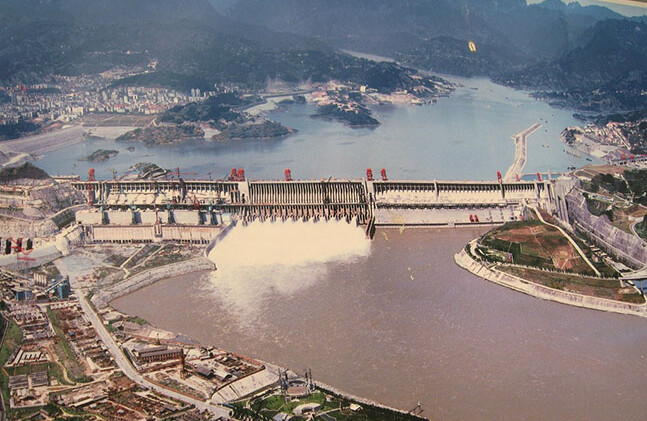For decades the World Bank has been the largest single financial supporter of dams in developing countries. But because of mounting criticism, in the late 1990s it greatly reduced its loans for large dams—although apparently it plans to increase them again.
Meanwhile, the Chinese have stepped into the breach and are going full-speed ahead with a spate of giant dams, both at home and abroad. These projects will displace millions of people, adversely affect wildlife, drown historical sites in some cases, and permanently alter and damage the environment.
Advocates of dams point out their potential benefits: protection from floods, clean and safe electricity (as opposed to coal or nuclear power plants), and reservoirs providing water for drinking and irrigation. But are the benefits all they are promised to be? And are dams worth the social, environmental, and economic costs? According to a report by the World Commission on Dams (WCD) in 2000, although considerable benefits have been derived from dams, "In too many cases an unacceptable and often unnecessary price has been paid to secure those benefits, especially in social and environmental terms, by people displaced, by communities downstream, by taxpayers and by the natural environment." Among its findings, the report states that the dams studied by WCD generated less power and less usable water than projected, plus they ran an average of 56 percent over budget. They can contribute to climate change, since rotting vegetation often gathers behind them, emitting greenhouse gases. This is just one of the unforeseen environmental consequences that dams can create. Others have pointed out that they are also tempting military targets.
So why the Chinese love affair with dams? The answer lies in the struggle to control their water supply, which has gone on for more than 2,000 years. Due to the extremes of the country's monsoon climate, there is often too much or too little water and either scenario can bring death or catastrophe to tens of thousands of people. Every summer brings flooding to some part of China, while in some years regions may suffer devastating droughts. Due to climate change and erosion caused by deforestation, the frequency and severity of flooding has increased, while for a variety of reasons the more arid north now suffers from a chronic water shortage.
To compound matters, China's territory has less than 15% of arable land, so its population is concentrated in the country's fertile river basins. With the more than doubling of the population since the early 1950s, the amount of people living in flood plains and reclaimed lands has increased dramatically, putting an ever-larger number of people at risk from floods. In addition, as China modernizes and becomes increasingly polluted, demand grows for electricity, preferably clean. Now their hard-won dam-building expertise is earning them both clout and cash abroad.
Before the nation's founding in 1949, China had few large-scale dams. The principal defense against flooding was dykes, which stretch for miles along China's main rivers and the Shanghai coast. The new government embarked on a series of projects across the country to control the waters. Over the next four decades, they built more dykes and more than 80,000 reservoirs and dams, large and small. But many projects were hastily and badly built. By 1981, 3,200 dams had collapsed—and that is only the official number. To this day, China has a legacy of shoddy dams and dykes that have to be upgraded at great expense.
Despite international and domestic opposition, and after decades of internal debate, China went ahead with the controversial Three Gorges Dam across the Yangtze, the largest dam in the world. Although the dam received some foreign investment, most of the funding came from China. The World Bank stayed away because of social and environmental concerns and has only been involved in eight Chinese dams. The 370-mile long reservoir begin filling in 2003, and the last phase will be completed in 2009.
By the time it is finished, a projected 1.5 to 1.9 million people will have been forced to leave their homes, some of them for far-away provinces where the language and customs are different. Over 24,500 hectares of farmland will be submerged, along with around 1,300 archaeological and historic sites, and the dam is already having far-reaching detrimental environmental effects. The jury is still out on whether the dam will solve the flooding problem, which was its primary purpose, since many fear that it will silt up rapidly.
Critics of the Three Gorges Dam and other large hydrodams point out that its electricity will be extremely expensive compared to other kinds of power plants, and that there are bound to be enormous variations in output, due to seasonal disparities in water flow and to inevitable operating problems, leaving consumers with blackouts or brownouts at times. What's more, China is in danger of going from a power shortage to a power surplus. In March 2005, the State Council called for immediate restraints on the rampant construction of power plants, warning of serious overproduction in the future. Meanwhile, eight more dams are planned for the upper Yangtze.
Some Chinese dams have ripple effects miles beyond the country's borders. Rising in Tibet and known in China as the Lancang, the Mekong River's lower reaches are the lifeblood for many in Thailand, Laos, and Cambodia, where about 20 million people are involved in fishing. The Chinese built the first Lancang dam in 1996, another in 2003, and have another six planned, with three already under construction. The largest of these, scheduled for completion in 2012, is almost as gigantic as the Three Gorges Dam. Already water levels of the lower Mekong are running lower than ever before, affecting both fishing and agriculture. China's dams upstream are most certainly a contributing factor. In addition to their many domestic projects, the Chinese are building dams across Africa. They are not constrained by environmental or human rights concerns, and dam construction has become a source of revenue and diplomatic influence.
One example is Sudan, which China relies on for oil. The proposed Merowe Dam in Northern Sudan will displace about 50,000 people, uprooting them from the Nile valley to dusty desert camps. The World Bank and the French government have refused to be involved in this project, because of human rights concerns. China's export credit agency stepped in with a loan of about 400 million dollars. Three Chinese companies have the main construction contracts. They are not alone—German, French, and Sudanese companies have also won Merowe contracts.
On November 6, 2006, President Hu Jintao gave support for funding up to 70 percent of the 600 million dollar Bui Dam project in Ghana, which has been on the drawing board since the 1960s, another project rejected by the World Bank and other multilateral agencies. The dam will flood nearly a quarter of the Bui National Park and have profound effects on the environment. Only about 400 hippos survive in Ghana, over 80% of which live at Bui, and it would be almost impossible to move them to another sanctuary as proposed, according to Daniel Bennett, a zoologist who was banned from working in the park. China is also involved in dam projects in Zambia, Ethiopia, and Mozambique, and one that spans the border between Toga and Benin.
China does respond to public pressure occasionally, at least for domestic projects. Gone are the days when people displaced by water projects could be quietly sent packing with a cash payment and no provision for resettlement, as they were in the 1950s. There are many complaints about the resettlement arrangements for the Three Gorges Dam—urbanites have fared better than farmers and there have been cases of embezzlement of resettlement funds—but at least there were plans in place, and the complaints have been made public.
It was announced in September that the on-again-off-again scheme to build up to 13 dams on the Nujiang (also known as the Salween), one of the only two free-flowing rivers left in China, has finally been cancelled, although it may yet be revived in a scaled-down form. The dams would have displaced more than 50,000 people and would have affected Myanmar and Thailand. This is a triumph for environmental groups both inside and outside China. In November 2006, a dam on one of Tibet's sacred lakes was also cancelled, due to concerns expressed by Tibetan and Chinese environmentalists. Nevertheless, many other Tibetan dam projects are still in the works; and Myanmar and Thailand are planning dams of their own, including one that may be even larger than the Three Gorges Dam.
It is clear that local environmental NGOs (a relatively recent phenomenon) and public opinion are having an increasing influence on government decision-making for domestic projects. Yet despite some concessions, it seems that the future will bring more yet more Chinese dams, both at home and abroad. We can only hope that growing public concern will make it in China's self-interest to consider all the consequences, whether in China or elsewhere, before pouring the next load of concrete.
(For more on rivers and dams worldwide, see International Rivers Network.)




